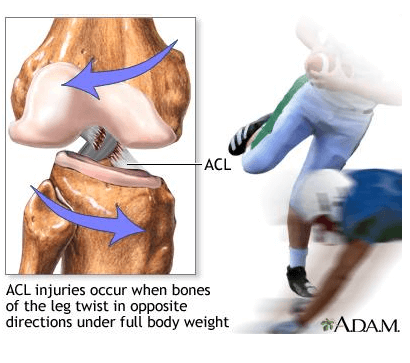An ACL injury occurs in the knee through the tearing or over-stretching of the ACL. The tearing could be a partial or complete tear of the ligament. The ACL helps connect your thigh bone (femur) to your shinbone (tibia). ACL injuries most commonly occur during sports that involve sudden stops or changes in direction, jumping and landing — such as soccer, basketball, football and downhill skiing. Often when this injury occurs, a “pop” sound can be heard, the knee becomes swollen, unstable and extremely painful. It then becomes difficult to put weight on the injured leg and activities such as walking becomes a challenge.
Anterior Cruciate Ligament (ACL) Injury

What is it?

What Causes Anterior Cruciate Ligament Injury?
This injury occurs when one changes direction suddenly, during pivoting/twisting movements, landing from a jump or when a knee is involved in a sudden stop. An ACL injury can also result from a very hard hit on the side of your knee. Your knee gives out from under you once you tear that ligament.

Symptoms Of The Anterior Cruciate Ligament Injury
An ACL injury causes significant knee pain when weight is applied to the knee. Swelling around the knee may also be a symptom of ACL injury, especially in the first few hours following the injury. At the time of injury, many athletes complain of feeling or hearing a loud “pop” from the knee. This is the sound the ligament makes when it ruptures. If you try to put weight on the injured knee, it may give out and feel very unstable. A person suffering from an anterior cruciate ligament injury is also unable to stretch their knee out completely, mostly due to the degree of swelling associated with the injury.

How Is The Anterior Cruciate Ligament Injury Diagnosed?
During a knee examination, your physiotherapist will look for any signs or symptoms of an ACL injury. They will ask you specific questions about how the injury happened and whether you heard any sounds at the time. They will assess for swelling and tenderness around the knee and compare the injured to the uninjured knee. They will perform special tests to determine whether that ligament has been injured. Some of these include the anterior draw test of the knee, Lachman test and pivot shift. Your physiotherapist will also assess your movement to see if it is restricted.
At times, the physical examination is not enough to conclude if you are suffering from the ACL injury. Other methods of diagnosis include:
- Ultrasound: This is when sound waves are used to visualise the internal structures of a knee such as the tendons, muscles and ligaments of the knee.
- X rays: An x-ray can be used to see if there is any evidence of a fractured bone, however, it cannot scan for soft tissue injuries such as a ligament tear. However, at times an x-ray may be recommended especially if there is a possibility that a person may have had a bony injury, as well as a ligament injury.
- Magnetic resonance imaging (MRI): This can be used to visualise both the soft and the hard tissues of the body such as the knee and clearly shows the extent of the injury.
Treatment Of An Anterior Cruciate Ligament Injury
Immediate first aid to the injured knee can reduce the swelling and the pain. There are four steps you can use to help treat the injury which is summarised using the acronym RICE (Rest, Ice, Compression and Elevation):
- Rest Is Helpful To Reduce Weight On The Affected Area.
- Elevate The Knees On A Pillow While Lying Down.
- Ice Is Used On The Injured Knee For 20 Min After Every 2 Hours, Especially In The First Few Days.
- Compression Wraps Or An Elastic Bandage Is Used To Compress The Knee.
An extensive exercise program that focuses on regaining strength, mobility and balance into the affected knee if necessary. As well as training the unaffected knee as well to prevent re injury as evidence suggest re rupturing the same ACL or the opposite ACL may occur due to an imbalance in treatment
Compression wraps and ice packs are sold at Masnad Health Clinic. Please visit the website to place your order today! Our therapists also specialise in cryotherapy, which is a type of cold therapy that has been shown to be effective in reducing pain and swelling in ligament injuries.

Rehabilitation
In the acute stage, your therapist may provide you with a knee brace and crutches to facilitate easier mobility. Physical rehabilitation will focus on reducing knee pain, swelling, restore full range of movement, strength, coordination and balance. A therapist can direct you onto exercises to perform at home or under supervision. Your doctor may recommend surgery to reconstruct the injured ligament depending on your age, the extent of the injury and your return to sport goals.
Prevention
These are some of the things you can do to prevent a similar injury. They include:
- Wearing Proper Footwear And Padding During Sporting Activities.
- Neuromuscular Facilitation Exercises
- Engaging In Exercises That Strengthen Your Leg Muscles, Specifically The Hamstrings.
- Training Techniques To Improve Knee Coordination, Proprioception And Balance that are sport specific such as Jumping.
- Following a sport specific exercise program
How Long Till I Get Better?
Depending on whether you have had surgery or have managed the injury conservatively (without surgery), the recovery process will be different. The latest research evidence suggests that delaying your return to sport until 9-12 months gives you the best outcome and reduces your risk of re-injury. This decision will be made in collaboration with your Doctor/surgeon, and your physiotherapist.

New Client Offer - 10% OFF
Are you in pain? Not sure if we can help you?
Book your initial appointment and receive 10% off any service!